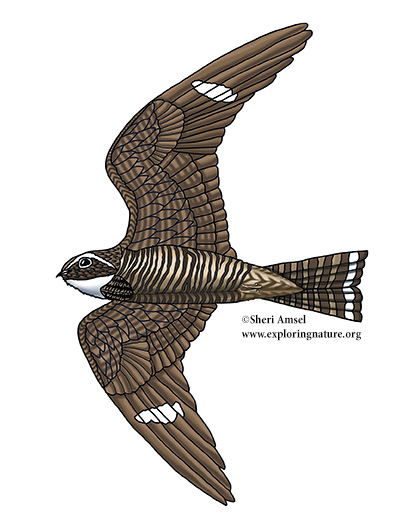

They breed from the Yukon, across Canada to Labrador, and south to southern California, Florida, and South America. They spend the winter in South America.
They can be found in open woodlands, fields and even in towns and cities.
They are a medium-sized bird with a large head and a tiny bill. They are very well camouflaged, with brown, black, and gray coloring and a striped (barred) chest. When they fly, you can see their long, pointed, bent wings and a bright white patch near the wing tip. Males and females look alike.
The male displays for females during the breeding season. He flies up high and then dives straight to the ground, but stopping before he hits and turning back up again. This sudden change in directions causes a booming sound that helps bird watcher know there is a nighthawk near.
They fly after insects in the early mornings and evenings looking like a big bat in the low light.
They don’t build a nest. The female lays 1-3 eggs on the ground in an open place, where she warms (incubates) them for almost 3 weeks.
Nighthawk Related Resources:
High Resolution Color Diagram
High Resolution Black and White Diagram
High Resolution Flying in Sky Mini-Poster
Kingdom: Animalia
Phylum: Chordata
Subphylum: Vertebrata
Class: Aves
Order: Caprimulgiformes
Family: Caprimulgidae
Genus: Chordeiles
Species: C. minor
When you research information you must cite the reference. Citing for websites is different from citing from books, magazines and periodicals. The style of citing shown here is from the MLA Style Citations (Modern Language Association).
When citing a WEBSITE the general format is as follows.
Author Last Name, First Name(s). "Title: Subtitle of Part of Web Page, if appropriate." Title: Subtitle: Section of Page if appropriate. Sponsoring/Publishing Agency, If Given. Additional significant descriptive information. Date of Electronic Publication or other Date, such as Last Updated. Day Month Year of access < URL >.
Amsel, Sheri. "Nighthawk (Common)" Exploring Nature Educational Resource ©2005-2024. December 13, 2024
< http://exploringnature.org/db/view/157 >


